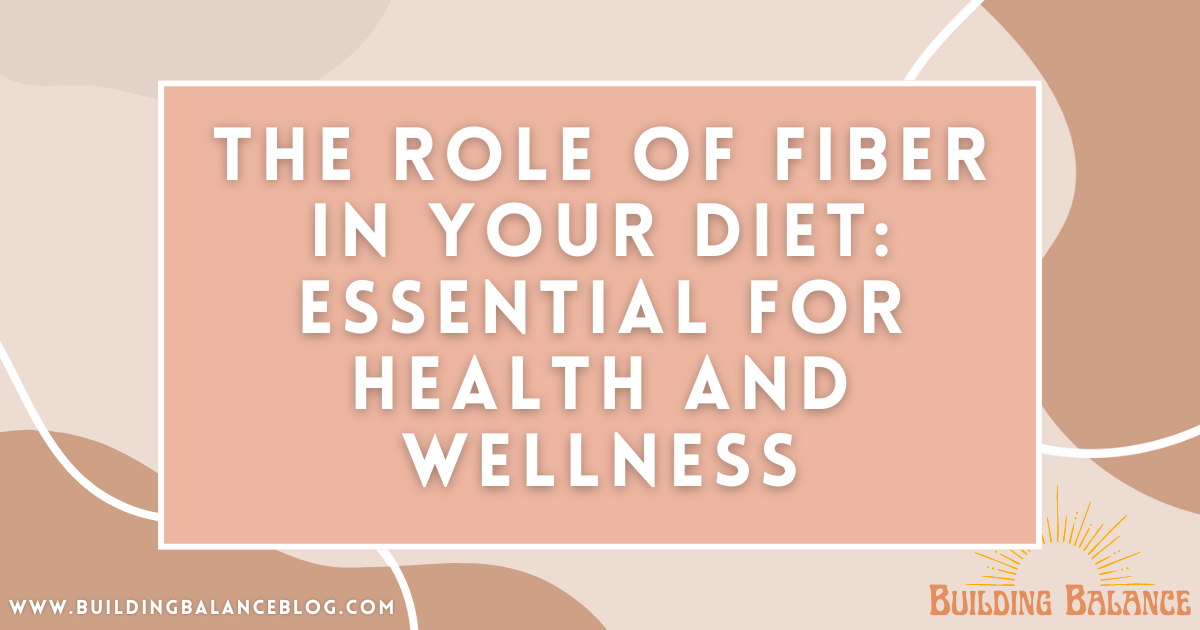
Fiber is often touted as a crucial component of a healthy diet, but many people might not fully understand why it’s so important. Fiber, a type of carbohydrate that the body cannot digest, plays a significant role in maintaining health and preventing disease. This blog post will delve into the different types of fiber, their health benefits, and practical ways to incorporate more fiber into your diet.
Understanding Fiber: Types and Sources
Fiber is found in plant-based foods and comes in two main types: soluble and insoluble.
Soluble Fiber:
Soluble fiber dissolves in water to form a gel-like substance. This type of fiber can help lower blood cholesterol and glucose levels. Good sources include oats, peas, beans, apples, citrus fruits, carrots, barley, and psyllium.
Insoluble Fiber:
Insoluble fiber does not dissolve in water. It adds bulk to the stool and helps food pass more quickly through the stomach and intestines. This can be particularly beneficial for those who struggle with constipation or irregular stools. Foods rich in insoluble fiber include whole wheat flour, wheat bran, nuts, beans, and vegetables such as cauliflower, green beans, and potatoes.
Health Benefits of Fiber
The benefits of a high-fiber diet are numerous and well-documented. Here are some of the key ways fiber can enhance your health:
1. Digestive Health:
Fiber plays a pivotal role in maintaining a healthy digestive system. Insoluble fiber promotes regular bowel movements and prevents constipation. It helps keep the digestive tract clean and reduces the risk of developing diverticular disease, a condition characterized by the formation of small pouches in the colon wall.
2. Heart Health:
Soluble fiber can help lower total blood cholesterol levels by reducing low-density lipoprotein (LDL), or “bad” cholesterol. High-fiber foods may also have other heart-health benefits, such as reducing blood pressure and inflammation.
3. Blood Sugar Control:
For people with diabetes, fiber — particularly soluble fiber — can slow the absorption of sugar and help improve blood sugar levels. A healthy diet that includes insoluble fiber may also reduce the risk of developing type 2 diabetes.
4. Weight Management:
High-fiber foods tend to be more filling than low-fiber foods, so you’re likely to eat less and stay satisfied longer. Additionally, high-fiber foods tend to be less energy-dense, meaning they have fewer calories for the same volume of food.
5. Reduced Risk of Certain Cancers:
A diet rich in fiber has been linked to a lower risk of colorectal cancer. Some studies have also suggested a link between a high-fiber diet and a reduced risk of breast cancer, although more research is needed in this area.
How Much Fiber Do You Need?
The Institute of Medicine provides the following daily fiber intake recommendations:
– Men aged 50 and younger: 38 grams
– Men aged 51 and older: 30 grams
– Women aged 50 and younger: 25 grams
– Women aged 51 and older: 21 grams
Despite these recommendations, many people fall short of the ideal fiber intake. On average, Americans consume about 15 grams of fiber per day, far below the recommended amount.
Tips to Increase Fiber Intake
Increasing your fiber intake doesn’t have to be difficult. Here are some practical tips to help you get more fiber into your diet:
1. Eat Whole Foods:
Focus on eating whole, unprocessed foods. Fruits, vegetables, whole grains, nuts, and seeds are all excellent sources of fiber.
2. Choose Whole Grains:
Whenever possible, choose whole-grain products over refined grains. Look for whole-grain bread, pasta, rice, and cereals.
3. Add Beans and Legumes:
Incorporate more beans, lentils, and peas into your meals. These are not only high in fiber but also rich in protein and other essential nutrients.
4. Snack on Fruits and Vegetables:
Keep fresh fruits and vegetables on hand for snacks. Apples, bananas, oranges, carrots, and celery sticks are easy and fiber-rich options.
5. Include Fiber-Rich Foods in Every Meal:
Aim to include a source of fiber with every meal. Add berries or a sliced banana to your breakfast cereal, include a salad with your lunch, and add extra vegetables to your dinner dishes.
6. Hydrate Well:
Fiber works best when it absorbs water, making your stool soft and bulky. Be sure to drink plenty of water throughout the day.
Potential Downsides of Too Much Fiber
While fiber is essential for health, consuming too much too quickly can lead to digestive discomfort, such as bloating, gas, and cramping. It’s important to increase fiber intake gradually, allowing your digestive system to adjust. Additionally, make sure to drink plenty of water to help fiber move through your digestive system.
Fiber is an indispensable part of a healthy diet, contributing to improved digestion, heart health, blood sugar control, and weight management. By understanding the types of fiber and incorporating more fiber-rich foods into your meals, you can reap the numerous health benefits that fiber has to offer. Remember to increase your fiber intake gradually and stay well-hydrated to avoid any potential digestive discomfort. By making fiber a regular part of your diet, you’ll be taking an important step toward better overall health and wellness.

